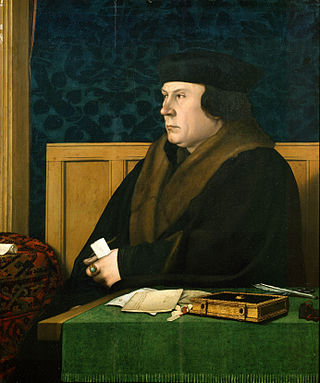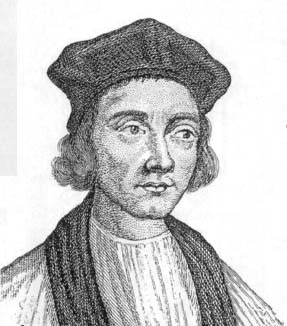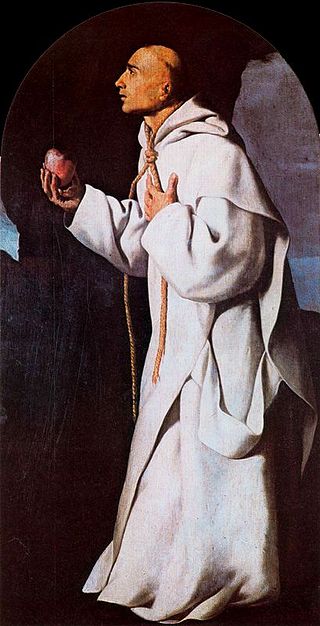Related Research Articles

Thomas Cromwell, briefly Earl of Essex, was an English statesman and lawyer who served as chief minister to King Henry VIII from 1534 to 1540, when he was beheaded on orders of the king, who later blamed false charges for the execution.

John Fisher was an English Catholic bishop, cardinal, and theologian. Fisher was also an academic and Chancellor of the University of Cambridge. He is honoured as a martyr and saint by the Catholic Church.

Reginald Pole was an English cardinal and the last Catholic archbishop of Canterbury, holding the office from 1556 to 1558, during the Counter-Reformation.

Edmund Bonner was Bishop of London from 1539 to 1549 and again from 1553 to 1559. Initially an instrumental figure in the schism of Henry VIII from Rome, he was antagonised by the Protestant reforms introduced by the Duke of Somerset and reconciled himself to Catholicism. He became notorious as "Bloody Bonner" for his role in the persecution of heretics under the Catholic government of Mary I of England, and ended his life as a prisoner under Queen Elizabeth I.

Robert Barnes was an English reformer and martyr.

Cuthbert Tunstall was an English humanist, bishop, diplomat, administrator and royal adviser. He served as Bishop of Durham during the reigns of Henry VIII, Edward VI, Mary I and Elizabeth I.

Elizabeth Barton, known as "The Nun of Kent", "The Holy Maid of London", "The Holy Maid of Kent" and later "The Mad Maid of Kent", was an English Catholic nun. She was executed as a result of her prophecies against the marriage of King Henry VIII of England to Anne Boleyn.

Thomas Percy, 7th Earl of Northumberland, 1st Baron Percy, KG, led the Rising of the North and was executed for treason. He was later beatified by the Catholic Church.

John Houghton, OCart was a Catholic priest of the Carthusian order and the first martyr to die as a result of the Act of Supremacy by King Henry VIII of England. He was also the first of the Carthusians to die as a martyr. As one of the Carthusian Martyrs of London he is among the Forty Martyrs of England and Wales.
Robert Johnson, a Shropshire native, was a Catholic priest and martyr during the reign of Elizabeth I.

John Rochester was an English Carthusian choir monk and martyr. He was hanged at York for refusing to concede King Henry VIII's supremacy over the church.

Humphrey Middlemore, OCart was an English Catholic priest and Carthusian hermit, who was executed for treason during the Tudor period. He is considered a martyr by the Catholic Church, and, along with other members of his religious order to meet that fate, was beatified by Pope Leo XIII on 9 December 1886.
John Larke was an English Catholic priest and martyr, who was executed during the reign of Henry VIII. Larke was a notable personal friend of Thomas More, Lord High Chancellor of England. Larke was beatified in 1886 by Pope Leo XIII.
German Gardiner was a Roman Catholic layman and nephew to Stephen Gardiner who became involved in the Prebendaries' Plot against Thomas Cranmer.
John Bodey was an English Roman Catholic academic jurist and lay theologian. He was martyred in 1583, and beatified in 1929.
Edward Powell was a Welsh Roman Catholic priest and theologian, in opposition to Henry VIII of England. He is a Catholic martyr, beatified in 1886.
Dr Richard Gwent was a senior ecclesiastical jurist, pluralist cleric and administrator through the period of the Dissolution of the Monasteries under Henry VIII. Of south Welsh origins, as a Doctor of both laws in the University of Oxford he rose swiftly to become Dean of the Arches and Archdeacon of London and of Brecon, and later of Huntingdon. He became an important figure in the operations of Thomas Cromwell, was a witness to Thomas Cranmer's private protestation on becoming Archbishop of Canterbury, and was Cranmer's Commissary and legal draftsman. He was an advocate on behalf of Katherine of Aragon in the proceedings against her, and helped to deliver the decree of annulment against Anne of Cleves.
The Archdeacon of Brecon is a senior ecclesiastical officer in the Church in Wales Diocese of Swansea and Brecon. The archdeacon is the senior priest with responsibility over the area of the archdeaconry of Brecon, which comprises the five rural deaneries of Brecon, Builth, Crickhowell, Hay and Maelienydd.
Charles Reynolds was an Irish Catholic cleric, canonist, and diocesan administrator. Born in County Leitrim into an Irish clan of Hiberno-Norse descent and son of Marcus Mac Raghnaill, Reynolds entered a religious order and was appointed to influential posts as archdeacon and military chaplain to the Earl of Kildare. His name in native Irish is Cathal Mac Raghnaill, but he used the Anglicized name of "Archdeacon Charles Reynolds" whenever he was in the Pale or in the company of English-speakers. He was educated at the University of Oxford and was multilingual; being fluent in English, Irish, and Ecclesiastical Latin. Archdeacon Reynolds opposed Henry VIII of England's policy of imposing Caesaropapism upon the Catholic Church in his dominions, declined to acknowledge him as Supreme Head of the Church of England, and refusing to acknowledge the annulment of the King's marriage to Catherine of Aragon or his uncanonical remarriage to Anne Boleyn.
References
- Stephen, Leslie, ed. (1889). . Dictionary of National Biography . Vol. 18. London: Smith, Elder & Co.
- Attribution
 This article incorporates text from a publication now in the public domain : Herbermann, Charles, ed. (1912). "Bl. Richard Fetherston". Catholic Encyclopedia . Vol. 13. New York: Robert Appleton Company. The entry cites:
This article incorporates text from a publication now in the public domain : Herbermann, Charles, ed. (1912). "Bl. Richard Fetherston". Catholic Encyclopedia . Vol. 13. New York: Robert Appleton Company. The entry cites: - John Pits, De illustribus Angliae scriptoribus (Paris, 1619), 729;
- Sander, tr. Lewis, Rise and Growth of the Anglican Schism (London, 1877), 65, 67, 150;
- Gilbert Burnet, History of the Reformation, ed. Pocock (Oxford, 1865), I, 260, 472, 566–67; IV, 555, 563;
- Thomas Tanner, Bibliotheca Britannico-Hibernica (London, 1748), 278;
- Original Letters Relative to the English Reformation (Parker Society, Cambridge, 1846), I, 209;
- Calendar of State Papers, Henry VIII, ed. Gairdner (London, 1882, 1883, 1885, VI, 311, 1199; VII, 530; VIII, 666, 1001.